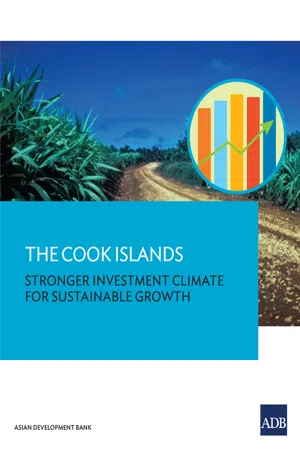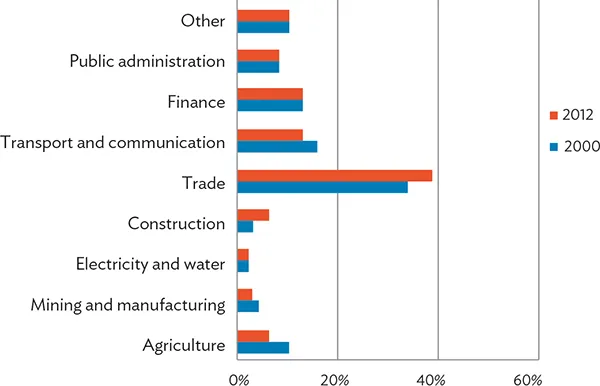![]()
1 INTRODUCTION AND OVERVIEW OF THE ECONOMY
The Cook Islands is among the best performing of the Pacific island economies. In the mid-1990s, an economic crisis reoriented the economy away from being government-dominated, to one that encouraged private-sector-led growth. However, the economy remains narrowly based on tourism and needs new investment to continue growing. Potential for developing nontourist-based industries is more limited. The country requires continued economic growth to support improvements to social programs, and help address emigration pressures resulting from open access of Cook Islanders to New Zealand and Australia.
This private sector assessment assesses the Cook Islands’ policy framework to identify areas that constrain private sector investment in the economy. It is based on a review of government planning documents; available economic reports; and discussions with government officials, donors, and representatives of the private sector.
A small, geographically isolated but relatively affluent country
the Cook Islands is located in the center of the Polynesian Triangle.1 The country comprises 15 main islands, with a total area of 240 square kilometers (km2). The islands are scattered in two groups over approximately 2 million km2 of ocean. The total population in 2011 was 17,794, of which 84% (14,990) were residents.2 Most people live on Rarotonga, where the capital, Avarua, and main commercial and government centers are located.
In 1965, the Cook Islands became self-governing in free association with New Zealand. This association provides Cook Islanders with New Zealand citizenship, and the right to work and residency in New Zealand. As a result of various reciprocal entry agreements between New Zealand and Australia (the main being the Trans-Tasman Travel Arrangements, allowing unrestricted living, visiting, travelling, and working rights for citizens of either country), Cook Islanders also have open access to work and residency in Australia.
Per capita, the Cook Islands is the most prosperous Pacific island economy (Figure 1). Its gross national income (GNI) more than quadrupled between 2000 and 2013 (from $5,546 to $23,026), and is between 5.1 times (Tonga) and 7.4 times (Vanuatu) that of its Polynesian neighbors. Its GNI is nearly 2.1 times that of Palau.3
Figure 1: Comparative Gross National Income Per Capita—2000 and 2013 ($)
Sources: ADB. 2014c. Key Indicators for Asia and the Pacific 2014. Special Chapter. Poverty in Asia: A Deeper Look. Manila. http://www.adb.org/sites/default/files/publication/43030/ki2014_0.pdf; ADB. 2015a. Asian Development Outlook 2015: Financing Asia’s Future Growth. Manila. http://www.adb.org/sites/default/files/publication/154508/ado-2015.pdf; and World Bank. World Development Indicators. http://databank.worldbank.org/data/reports.aspx?source=world-development-indicators# (accessed 3 July 2015).
Labor force participation is relatively high, with approximately 72% of Cook Islanders in some form of employment (footnote 2). The country also enjoys a high standard of health care and education. It is one of the few Pacific island countries offering a wide range of welfare support to children, the sick, and the elderly. The Cook Islands is on track to achieve the Millennium Development Goals by the end of 2015, and reported achieving Goal 4 (“reduce child mortality”) and Goal 5 (“improve maternal health”) by 2010.4
Economic reforms in mid-1990s emphasized the need for private-sector-led growth
The Cook Islands economy grew strongly from the early 1980s until 1994, driven by tourism and public spending. A significant crisis emerged in 1996. Successive governments had used public sector employment to deliver political patronage and as a form of social security, particularly on the outer islands. Continuous tourism growth, generous aid flows, and external borrowing had masked this behavior.
However, a tourism decline precipitated a monetary and fiscal crisis, resulting in lost confidence in the Cook Islands currency and the government’s inability to meet its financial commitments. In response, the Cook Islands currency was withdrawn and the New Zealand dollar became the country’s sole currency. An economic reform program (ERP) was also implemented to restore macroeconomic stability and reduce the government’s domination of the economy. The ERP was also introduced to create an outward-looking, competitive economy led by a growth-oriented private sector.5
The ERP reduced the size of the public service, cut other expenditures, and introduced tax reforms. This restored financial stability, and enabled the government to successfully restructure its unsustainable external debt levels. As a result, the economy experienced a return to growth.6
Volatile economic growth since 2000
The Cook Islands economy has experienced significant swings in economic output since 2001 (Figure 2). While annual gross domestic product (GDP) grew at an average rate of 1.2% in 2001–2015, the country also experienced several years of economic contraction. In 2007 and 2010, this volatility was largely due to the global economic crisis and beyond the government’s control.
Figure 2: Cook Islands Gross Domestic Product at Constant Prices, 2001–2015 (% annual change)
a Forecast
Sources: For 2001–2009, Asian Development Bank (ADB). 2014c. Key Indicators for Asia and the Pacific 2014. Cook Islands Country Table: 31 July. https://sdbs.adb.org/sdbs/KI_fileDownload.jsp?key=COO&scope=country&file=CT_COO.pdf; and for 2010–2015 (forecast), ADB. 2015a. Asian Development Outlook 2015: Financing Asia’s Future Growth. Manila.
Yet, the economy’s small size and narrow focus make it particularly vulnerable to external shocks.
Economy narrowly focused on tourism
The trade sector dominates the economy, and includes restaurants and accommodation (Figure 3).7 The trade sector’s share of total GDP increased from 32.4% in 2000, to an estimated 39.3% in 2012.
Figure 3: Cook Islands Contribution to Gross Domestic Product by Industry at Constant Prices, 2000 and 2012 (%)
Source: ADB. 2014c. Key Indicators for Asia and the Pacific 2014. Cook Islands Country Table: 31 July. https://sdbs.adb.org/sdbs/KI_fileDownload.jsp?key=COO&scope=country&file=CT_COO.pdf
The national system of accounts in the Cook Islands does not have a way to estimate tourism’s contribution to the economy. Still, tourism is considered the country’s leading sector, and is thought to dominate economic activity. It accounts for an estimated 60% of GDP.8
While merchandise exports increased in 2013 due to an increase in fish exports, the amounts remain small relative to merchandise imports. However, the country’s negative merchandise balance is more than offset by a positive net services balance based on tourism.9
Besides tourism, other key sectors contributing to the economy include marine resources, agriculture, and financial services. The short-to-medium prospect for substantive growth in nontourism sectors appears limited, and it is critical that the tourism industry remains dynamic and healthy.
Sluggish private sector investment
Economies grow and create jobs as a result of productive investment. Data on private sector investment levels in the Cook Islands are not readily available. However, the Ministry of Finance and Economic Management tracks commercial building permits, providing a good indication of businesses’ outlook for the economy. When an economy is expanding, businesses will invest in new buildings, purchase equipment, and improve existing facilities to meet anticipated growing demand.
The value of commercial building approvals issued in the Cook Islands was relatively flat in the 5 years over 2010–2014. While the figure slightly improved in 2014, the 5-year total is still considerably lower than in 2008 and 2009 (Figure 4). This is despite continuous growth in the country’s visitor numbers. Encouraging new investment is needed, particularly in the tourism sector, to sustain and improve the country’s standard of living.
Figure 4: Cook Islands Value of Commercial Building Approvals, 2008–2014 (NZ$ million)
NZ$ = New Zealand dollar.
Source: Government of the Cook Islands, Ministry of Finance and Economic Management, Statistics Office. 2015b. Miscellaneous Statistics March Quarter 2015—Table 7.1 Building Approvals. http://mfem.gov.ck/mfemdocs/stats/statistical-series/miscellaneous/2015-2/934-miscellaneous-statistics-tables-march-2015
Depopulation a significant challenge
Depopulation has been an issue in the Cook Islands since the 1970s. Over 1996–2011, the total resident population declined by 17%,...




